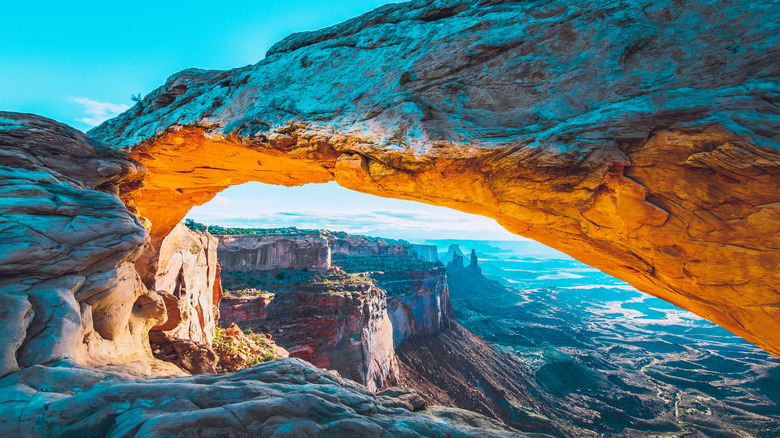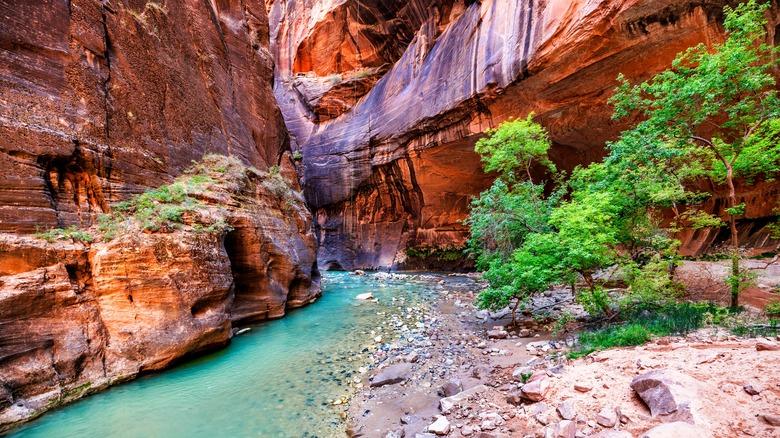The Best Itinerary For A Scenic, Unforgettable Road Trip To Utah's 5 National Parks
Utah's "Mighty 5" national parks are like a close-knit family, always trying to top one another in a friendly game of sibling rivalry. Zion, Bryce Canyon, Capitol Reef, Canyonlands, and Arches all have distinct personalities, made possible by their unique attributes: gorgeous canyons, otherworldly hoodoos, insightful pioneer history, captivating vistas, and imposing arches, respectively. Ten million visitors pass through them each year, and there's something for every kind of traveler.
Accessible viewpoints may tempt the indoorsy out of their air-conditioned cars, while outdoorsy types have their pick of several of the best National Park trails that are only for experienced hikers. The total driving distance to link them together, from Zion in the south to Arches in the north, is about 350 miles. Therefore, by the time someone in the back seat whines, "Are we there yet?" the answer will probably be "yes." The drive itself is an attraction, and each park has its own crown jewel of a scenic drive.
To get the most out of it all, Redditors sing the praises of GuideAlong, an app that narrates the sights as you drive, keyed to your GPS location (there's a discounted bundle for The Mighty 5). Zion National Park is closest to Las Vegas and our pick for the best place to start. Prefer Salt Lake City? Just reverse the order of our eight-day itinerary. Make it a loop, and you can include a stop at Horseshoe Bend, another much-photographed mesmerizing natural wonder.
Days 1 to 3: Zion — with and without crowds
Zion National Park is within close driving distance of Las Vegas. If it's your first stop, you might wonder if it's crowded in the summer. The answer is "yes." Is it too crowded? That's subjective, and it all depends on your mindset. If you stay positive, you'll soon trade smiles with strangers as you wade through the famous Narrows, score a hard-to-get permit, and hoof it up the crazy-scary trail to Angel's Landing. Hot tip: The view from Observation Point is even better than the one from Angel's Landing, and the hike there is a little more rigorous but a lot safer.
If you're tempted by the shoulder seasons, fall can be glorious, but spring runoffs close down the famous canyon hikes, so that might not be the best time to plan a visit. Our advice? Just go when you want. The park operates two shuttle routes in peak season, one through the park itself, stopping at viewpoints and trailheads, and another to the major hotels nearby, so you can easily spend two days exploring.
Day three takes you away from crowds to Zion's other entrance at Kolob Canyons. An hour away along the road to Bryce Canyon, Kolob is blissfully undiscovered. Book a trip with a professional outfitter, and you can try canyoneering here. Options range from gentle, introductory half-days to trips that'll have you rappelling down red rock walls in a wetsuit to plunging into pools of icy green water.
Day 4: Bryce Canyon has that hoodoo voodoo
What is a hoodoo? A spire-like geological formation formed out of soft rock walls by rainwater. Bryce Canyon National Park is home to thousands upon thousands of them, each as unique as a snowflake. Think of hiking through veritable forests made of stone. Believe us, Bryce Canyon's Amphitheater (pictured above) is every bit as stunning as that more famous Southwest hike that has become nearly impossible to do, the Wave.
The easy, must-do hike here is the Navajo Loop, which starts at Sunset Point and loops down into the Amphitheater and back, packing a lot of splendor into a short 1.4 miles. One of these is the much-photographed Wall Street, a set of switchbacks that ping back and forth between towering rock walls. It might seem like the canyon is teeming with as many pedestrians as you'd see on New York's Wall Street, but press on, as many of the selfie-stickers will turn back here.
If you are still game, add on the Peek-a-boo Loop, thick with magical stands of hoodoos, or if you are brimming with energy and confidence, tackle the magnificent Fairyland Loop, an 8-mile, challenging hidden gem. You may only need a day in Bryce Canyon, but be sure to leave enough daylight for yourself at the end of your exploration. This will help you to enjoy the 122-mile drive along Scenic Byway 12 to Capitol Reef, which is considered the best scenic drive in the state by reviewers.
Day 5: Will Capitol Reef will be your favorite?
This park is a sleeper hit among visitors, with many who tour the Mighty 5 calling Capitol Reef National Park "the mightiest of all." One highlight is the Fruita Rural Historic District, a lush, green valley filled with fruit trees and a smattering of historic buildings surrounded by soaring sandstone cliffs. Grab a slice of pie made from locally grown apples at the Gifford Homestead. Or, pick your own fruit – cherry, apple, peach, or pear, depending on the season – and take a stroll on a boardwalk to see some 1,000-year-old petroglyphs.
Then go pitch your tent on grass, under the shade of a tree, because the campground here is a veritable oasis. If that is, you scored a reservation — This is one of the 10 most difficult campgrounds in the country to book. Plan your visit for springtime, when the fruit trees have blossomed, and be prepared to swoon at the loveliness of this rural scene.
On your way from Capitol Reef to Canyonlands, make time for a stop at the wonderful Goblin Valley State Park, the Western state park that has you covered for wild outdoor adventures. If you didn't get a reservation at Fruitas, you can spend the night here at a superb campground. It offers some of the most dramatically sited glamping yurts we've ever seen, tucked among groves of goblin-shaped boulders.
Days 6 to 7: Canyonlands — on and off the beaten path
If your screen-tired eyes crave sweeping vistas, you'll appreciate Canyonlands National Park's Island in the Sky, a sandstone mesa overlooking dramatic geological formations and the elegantly snaking Green and Colorado Rivers. This is a great driving loop through the least-visited of the Mighty 5, with lots of turnouts where you can get out to gaze or take a short hike. "The viewpoints ... surpassed most of the rim viewpoints at Grand Canyon for me," writes one Redditor on r/NationalParks. This is where you will find the 0.6-mile trail to Mesa Arch, where the rising sun sets the red rock arch aglow as it rises through the span's elegant curve. This is such a popular photo-op that the parking lot can fill up well before dawn.
You can see the elegant sandstone spires called the Needles from the Island in the Sky, but it's magical to wander among them, so make this day two. The ranger-recommended hike to Druid Arch involves some scrambling and even a climb up a permanently affixed ladder, but it covers a huge variety of terrain. But there is an even better way to see remote Canyonlands: bumping along dirt roads in a jaunty jeep. Book an adrenaline-fueled 4x4 adventure tour, an experience that consistently gets rave reviews. Or, if you're truly intrepid, rent a 4x4 in Moab on your own. You'll need one to get to the trailhead for the Maze, Canyonlands' dangerous yet splendid bucket-list hike.
Day 8: Arches is a geological wonderland
Arches National Park contains over 2,000 of its namesake rock formations, and we'll never get tired of trying to see them all. These sandstone arabesques are fascinating, maybe because their swoops and curves seem full of motion, yet paradoxically, they've been standing still for thousands of years. Arches and Canyonlands are only 26 miles apart, and nearby Moab makes a perfect base for the last few days. For a side trip, an underrated state park with views like the Grand Canyon is just 30 miles away.
Arches uses a strictly timed reservation system that fills up three months in advance. But don't despair because there's a workaround: Arrive before 7 a.m. or after 4 p.m., and it's perfectly legal to drive right in. You'll want to go early anyway because sunrise at Delicate Arch is not to be missed. "One of the coolest things I've ever seen," a Redditor writes in r/NationalParks. "Watching the scenery go from blue to purple to red to orange is incredible."
At an area called Devils Garden, dense with arches, spires, and rock fins, you'll find the surprising Double O Arch. It's a whimsical delight that somehow makes you want to laugh out loud, and the awe-inspiring Landscape Arch is 6 feet wide and 300 feet long. You started at dawn, so end with a ranger-led hike through the slot canyons of Fiery Furnace, which gets its name from its electric crimson glow at sunset. A perfect end.





